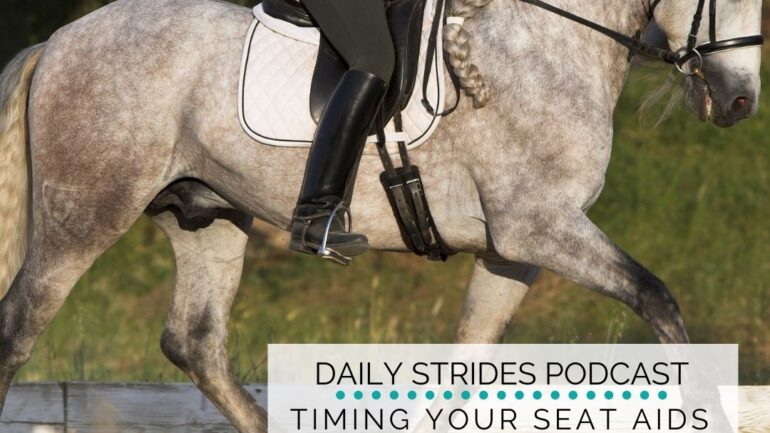Timing… It’s an important element of great conversations. You can give all the correct responses, but if the timing is off – they are not as meaningful. And this affects the connection and flow. Horse riding is the same.
After all, horse riding is just a word we use to describe the conversation between the rider and the horse.
As a rider, it takes time to learn how to move one part of our body while having minimal influence on other parts. Part of improving your ability to do this is to work on developing your aids independently of each other. And the other part is to become very aware of what you are saying and when. It takes time to develop your independent aids and, as a result, your independent seat.
However, while you are working on doing these, you can also start to become more aware of when you are communicating. You can work on the timing of your seat aids.
In this episode, I want to focus on the ‘when’ part of your conversation. And specifically, the aid that we tend to get most muddled up about – your seat.
Exercise 1:- Feeling in the Walk
I spend a lot of time with my novice riders working on this. I think that understanding what is happening underneath you from the beginning, makes developing your timing (and coordination) so much easier as the weeks and months go by. However, regardless of how long you have been riding, becoming mindful about what is happening underneath you will always help improve your skills as a rider.
Your seat bones will move like the pedals of a bicycle if you were peddling backward. Down and forward, up and back.
Once you can feel this happening, I want you to begin merging this with what your horse’s back legs are doing. As your horse’s right back leg moves forward, your right seat bone will drop down slightly and swing forward as well. While this is happening, you and your horse’s body will be moving over your horse’s left back leg. It will be on the ground bearing the weight. This will cause your left seat bone to feel like it is moving backward while raising up slightly.
If you’re struggling to feel anything, try taking your feet out of your stirrups. You can also if it is safe to do so, close your eyes. Finally, you can glance at your horse’s shoulders and go from there.
Exercise 2:- Walk to Trot Transition
The second exercise to help with developing the timing of your seat aids is working on that often overlooked transition from the walk into a trot. This is one of the earliest transitions we ride when we just get started. And, often, because of this, we don’t tend to work on developing it a whole lot! Which is a pity – there’s a lot to be learned from riding this transition.
To practice this, I first am going to suggest getting off your horse and onto a firm ‘dining’ type chair. Then feel what you do with your core as you’re about to ‘stand up’ out of the chair.
It is important to be mindful that you are not using your arms or hands to stand up. Just your core and then, your legs. Feel the shift that happens just before you stand. The engagement of the core. This feeling is what you will then take with you into the saddle.
Practice creating that same feeling with your core in the saddle. The feeling of asking for the trot, from the walk, and just as your horse takes that first step, ‘lightening’ your core.
The more you do this, the better you will become at timing it to just the right time where you allow the energy to flow underneath you. This same technique can then be modified and practiced with other upward transitions.
Exercise 3:- Walk to Canter Transition
This is maybe one of my favorite transitions to work with riders on. Particularly when it comes to refining the timing of the aids to coordinate with the horse’s movement. Start in the walk and noticing, using exercise 1, what is moving when at any given time. Then, combine this with exercise 2, allowing the energy to flow when you ask.
It is very easy to tell if you get your timing right when asking for the walk to canter transition. Failing to do so usually results in a little ‘double step’ from your horse
The goal is to ride a ‘clean’ transition. The preparation was done. You asked at the right time. And then you allowed with your seat as the horse stepped into the canter.
Connection Between Seat & Hands
Finally, as you are working on all of the above, pay attention to how your seat leads your hands. Often riders get this backward. They allow their hands to lead the seat. Timing is important. Paying attention to this will help you become more mindful of how you are using your aids and when.
Practice this… And see how you develop it over a matter of days with your horse.
Happy Riding
Lorna
Additional Resources:-
-
-
- Conscious Transitions Between Walk & Trot
- Connection in Your Riding; Seat and Legs
- FREE Download:- 1 Exercise Multiple Ways
- The Daily Strides Podcast on iTunes
- The Daily Strides Podcast on Stitcher Radio
- Join Connection Today
- Online Community for Equestrian focusing on Planning and Mindset
- Lunging for Riding
-

